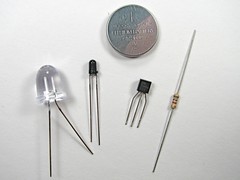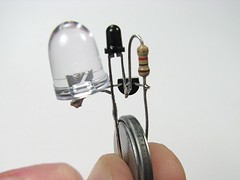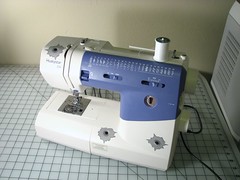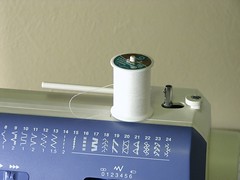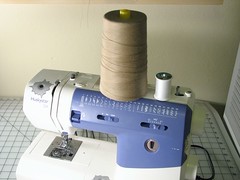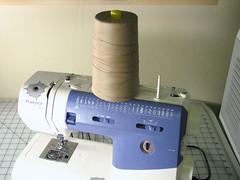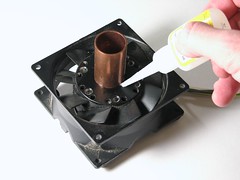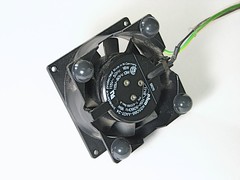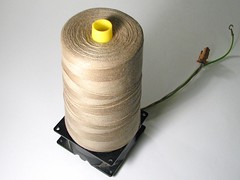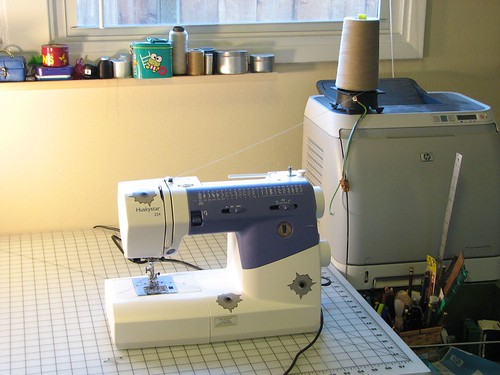Even if you’re not a home brewer dealing with the hops shortage, hop plants are great to have in your garden. The trick is that they like to grow vertically up twine, so you have to rig a trellis. You can make one using scraps of soaker hose and antenna wire while taking advantage of tree trunks already in your garden.
Tag Archives: diy
How to make a Sawed-off USB Key
Holy crap– somebody just went and TORE MY FREAKING USB CABLE IN HALF while it was still attached to my laptop!!!
No– wait– sorry. That’s just my USB drive. My bad. Never mind.
(And after the jump, how to make your own.)
Continue reading How to make a Sawed-off USB Key
Five Minute Project: iPod Cozy
The iPod Touch (or iPhone, for that matter) is a slim little thing that fits well in all kinds of places. However, in pockets and bags, it runs the risk of getting scratched unless you protect it. Here is a super quick fabric sleeve you can make to keep your lovely device safe. It is snug enough that it won’t fall out, even when shaken upside down. As an added bonus, you can even use the multi-touch screen through the fabric. A few minutes and a few cents worth of fabric seem like a bargain when compared with the exorbitant prices and shipping costs (or, even worse, a trip to the mall!) for the commercial variety.
Continue reading Five Minute Project: iPod Cozy
A Velvet Bristlebot Racing Snail
A few weeks ago we showed you how to build a BristleBot, a tiny vibrating robot (vibrobot) that is formed from the unlikely union of a toothbrush (with directional bristles) and a vibrating pager motor. Despite its simplicity, it drives like a drunken bat out of hell– propelled by the ratcheting action of the vibrated bristles.
Of course, toothbrushes aren’t the only system where you can find find oriented bristles. Approaching this process from an entirely different perspective, it turns out that certain types of velvet can also form a directional bristle system that can be driven with vibrations. Here we build a plush racing snail– a velvet vibrobot that crawls forward… at a snails pace.
Continue reading A Velvet Bristlebot Racing Snail
One Hundred Percent EDIBLE Googly Eyes!
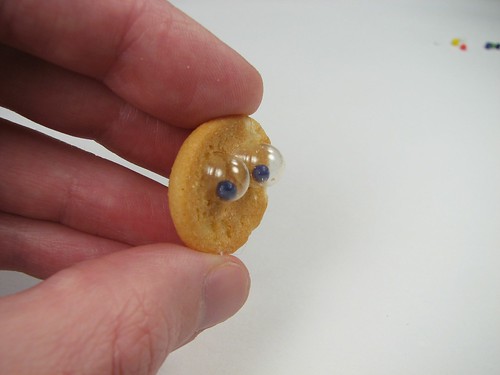

After more than a year of painstaking directed research by our Experimental Foods Division, we have finally achieved one of our most important longstanding goals: the production of edible googly eyes. Like many other great inventions, it seems almost simple in retrospect, but in this write up we walk through the process and show you how to make your own.
Continue reading One Hundred Percent EDIBLE Googly Eyes!
Vintage Software Documentation Purse
Vintage software documentation often comes in 6″ x 9″ three ring binders which are just the right size for a small handbag. Many of them are cloth bound, making them ideal for reuse. Tech surplus stores such as Weird Stuff are good places to look for interesting covers, like this Pepper Graphics user’s guide from Number Nine. With the addition of a fabric liner and handles it has become an excellent geek purse.
Continue reading Vintage Software Documentation Purse
A Simple and Cheap Dark-Detecting LED Circuit
Here’s a simple problem: “How do you make an LED turn on when it gets dark?” You might call it the “nightlight problem,” but the same sort of question comes up in a lot of familiar situations– emergency lights, street lights, silly computer keyboard backlights, and the list goes on.
Solutions? Lots. The time-honored tradition is to use a circuit with a CdS photoresistor, sometimes called a photocell or LDR, for “light-dependent resistor.” (Circuit Example 1, Example 2.) Photoresistors are reliable and cost about $1 each, but are going away because they contain cadmium, a toxic heavy metal whose use is increasingly regulated. There are many other solutions as well. Look here for some op-amp based photodetector circuits with LED output, and check out some of the tricks used in well-designed solar garden lights, which include gems like using the solar cell itself as the sensor. (Our own solar circuit collection is here.)
In this article we show how to build a very simple– perhaps even the simplest– darkness-activated LED circuit. To our LED and battery we add just three components, which cost less than thirty cents altogether (and much less if you buy in bulk). You can build it in less than five minutes or less (much less with practice).
What can you do with such an inexpensive light-controlled LED circuit? Almost anything really. But, one fun application is to make LED throwies that turn themselves off in the daytime to save power. Throwies normally can last up to two weeks. Adding a light-level switch like this can significantly extend their lifetime.
Continue reading A Simple and Cheap Dark-Detecting LED Circuit
Iterative Algorithmic Plastic Sculpture: Fimo Fractals
One of our favorite shapes is the Sierpinski triangle. In one sense, a mere mathematical abstraction, on the other, a pattern that naturally emerges in real life from several different simple algorithms. On paper, one can play the Chaos Game to generate the shape (or cheat and just use the java applet).
You can also generate a Sierpinski triangle in what is perhaps a more obvious way: by exploiting its fractal self-similarity.
Continue reading Iterative Algorithmic Plastic Sculpture: Fimo Fractals
5-minute project: Spool spinner from an old fan
One of the common features on small “straight-stitch” sewing machines is a little rod on the top, called a spool pin. The spool pin holds a spool of thread and allows it to turn freely and feed out thread while the machine operates.
Seems straightforward enough, right? But what if you want to start working with larger spools of thread? Here’s an example that we brought home recently that, on first blush, just doesn’t look like it will work:
By comparison, the standard spool of thread looks puny, and the spool pin looks even punier. Even if this large spool were able to fit onto our tiny spool pin, it could not spin freely because of its weight and friction.
So how can we use the spool? Our solution was to design a larger, heavy-duty “spool spinner,” incorporating low-friction precision ball bearings. Total budget: $0.00– using stuff from the junk bin only– and under five minutes.
Parts used: an old “box” or “muffin” fan (the older and heavier the better), some rubber feet, a little piece of copper pipe, and superglue.
The fan that we found is an old 120 V AC type, made of cast aluminum and very sturdy. It doesn’t matter if it is electrically good; all that matters is that it spins well. To the spinning part of the fan we added a short copper pipe as our center pin, which turned out to be about the right size for the center of this particular spool. We used superglue to hold the copper piece in place. (Note: waiting for the glue to cure is the slow part of this build.)
Add rubber feet to the other side of the fan and it’s ready to go.
Rather than keeping ours on top of the sewing machine we put it on the printer next to the sewing table, where it is less likely to get knocked over. (Side note: The cat enjoyed this setup.)
In practice, the fan bearing turns freely enough that the sewing machine can spin the spool as needed, but not so freely that it starts to turn and then unwinds the whole spool, so it works quite well.
Obviously this is a quick hack and is not the only approach to the problem– there’s nothing so fancy as a ball-bearing spool spinner on an industrial sewing machine, even though it can use huge spools. Instead, the spool is held in place while the thread is pulled off axially through a well-defined aperture. (Spools like this one, as you can tell from the slight conical taper, are actually designed to be used that way.) An advantage of our “spinner” design is that it works equally well with many different kinds of spools. It could even be a useful tool when winding coils from spools of wire.
Umbrella Bat Costume Update: Now more anatomically correct!
This updated bat costume puts wing spreading at your fingertips where it belongs. It also boasts a more impressive and slightly more dangerous wingspan. Watch where you point your wingtips!
Continue reading Umbrella Bat Costume Update: Now more anatomically correct!









